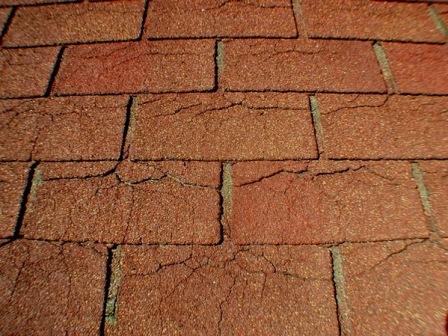Mastering Roof Inspections: Asphalt Composition Shingles, Part 32
by Kenton Shepard and Nick Gromicko, CMI®
The Asphalt Layer
The part of the shingle most important in making shingles waterproof is the asphalt. In addition to waterproofing, asphalt provides thickness, weight and durability to shingles. Shingles with a thicker layer of asphalt last longer than similar shingles with a thinner layer.
Producing asphalt that will retain its performance characteristics over a wide variety of environmental conditions is not easy, and it’s the failures that you’ll be looking for.
The properties of asphalt vary, depending on the chemical properties of the crude oil from which it’s produced, and how that crude is processed. The chemicals and materials that are added to the asphalt mixture and their proportions also affect the different properties of the asphalt.
The main shingle elements connected with the asphalt layer and how well it stands up to weather over the long term are volatiles, shingle ductility, and the transition temperature of the asphalt.
Volatiles
“Volatiles” are chemical compounds with a low boiling point that are added to the asphalt mix to help keep shingles waterproof and flexible. Over the years, volatiles are slowly lost to evaporation and, to a lesser extent, the various effects of moisture.
Loss of volatiles causes asphalt to dry, shrink and crack. Heat speeds this process because it increases the rate at which volatiles evaporate. This means that keeping the shingles cool will help slow the loss of volatiles and extend the length of the shingles' long-term service life.
Loss of volatiles can cause craze-cracking. Drying and shrinking can cause craze-cracking. Craze-cracking appears as random cracking in the shingle's weather surface. The shingle surface exposed to the weather loses volatiles more quickly than the interior parts of an asphalt shingle that are not directly exposed to the weather. This faster rate of volatile loss causes the weather-exposed surface to dry more quickly than the shingle's interior. As the asphalt layer loses volatiles, it also loses mass, which causes the shingle's surface to shrink in size. The different rates of shrinkage between the surface exposed to weather and the shingle's interior are called “differential shrinkage." Differential shrinkage between the surface and inner asphalt can cause tensions to develop that are relieved by cracking, which happens randomly across the shingle's surface.
This random cracking is not continuous through the shingle and mat, but is limited to the shingle's surface, although it becomes increasingly deep and widespread over time. The following photos are examples of craze-cracking.




You may find craze-cracking in either organic or fiberglass shingles. It’s a sign of aging, but it’s not a defect unless cracking appears prematurely. Cracking that is considered premature for high-quality shingles may be different than cracking that's premature for low-quality shingles, so, unfortunately, it’s difficult to make generic statements about when craze-cracking is premature. It’s not unusual to see craze-cracking begin to appear after 10 or 12 years, especially in harsher climates. Too much filler in the asphalt mix can contribute to premature craze-cracking.
**************************************************
Learn how to master a roof inspection from beginning to end by reading the entire InterNACHI series: Mastering Roof Inspections.
Take InterNACHI’s free, online Roofing Inspection Course
Mastering Roof Inspections
Roofing Underlayment Types
Inspecting Underlayment on Roofs
Fall-Arrest Systems
Roofing (consumer-targeted)
More inspection articles like this

